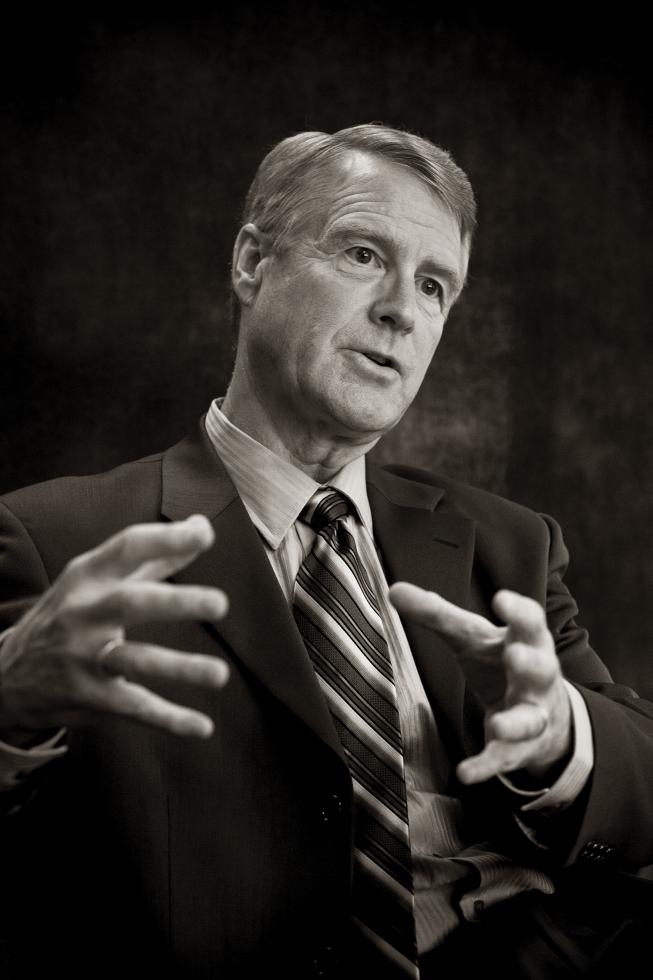California’s ongoing economic slump has been historically challenging to local governments, even in relatively affluent areas like Folsom, which has one of the highest per capita incomes in the Capital Region. We sat down recently with Folsom City Manager Kerry Miller to discuss the city’s current fiscal condition and plans it has to thrive as the economy improves.
Comstock’s: This has been a devastating time
for most local governments. What is Folsom’s current economic
condition?
Miller: I guess the good news is that we
continue to have a relatively high employment rate, and our
property tax values have declined less than other areas in the
region. I think we’re one of the best situated cities in that
regard in the Sacramento area. But we’ve taken the same hits as
other communities. We have a lot of retail, such as the auto mall
and the factory outlets, and we’ve seen a significant decline in
our sales tax revenue. That has created a significant strain on
our general fund budget and our ability to fund services.
Comstock’s: You just hired a new police
chief. How did the city’s economics fit into your search? Are
small locales like this one able to compete for top
talent?
Miller: I think Folsom fares well in the
recruitment process just because of the quality of life we have
in the community. So when we go out for executive recruitment, we
usually get a pretty good response. What may have had the
greatest impact in this particular recruitment is that we have
already instituted pension and other benefit reform in our police
department, so this was our first executive recruitment under
what is called a second-tier retirement plan, which is much less
lucrative than the existing retirement program of our current
employees. Would we be able to draw a highly qualified and
competent pool of candidates given that the benefits we would
offer would be significantly less? … As it turned out, we ended
up having a very solid pool of candidates, particularly the top
group of candidates we interviewed. My assessment is that any one
of those (people) would have been able to step into this job and
do a very good job of it.
Comstock’s: You mentioned pension reform,
which has become a flashpoint for state and local governments all
across the country. How has your city addressed this
issue?
Miller: We have successfully instituted pension
reform with all of our bargaining units. With our police
officers, for example, we’ve instituted a two-tier retirement
plan where new hires will come in at the 2-percent-at-50
retirement formula (2 percent of annual salary multiplied by the
number of years worked) versus the current 3-percent-at-50 plan.
That results in significant long-term cost savings for the city.
In addition, we’ve implemented a pension calculation of a
three-year average salary versus single-year highest (basing the
rate on a worker’s highest single earning year). For our
nonsafety employees, we’ve created a second-tier 2-percent-at-55
plan versus the 2.7-â?¨percent-at-55 formula. Again, that results
in significant long-term savings as well as a three-year average
versus highest single year. With both groups of employees, next
year will culminate a two-year transformation where at the end of
that period of time employees will be picking up 100 percent of
their share of their [California Public Employees’ Retirement
System] contribution. That changes from the city in total picking
up their share.
Comstock’s: Folsom’s plan to annex and
develop more than 3,000 acres south of Highway 50 is one of the
most ambitious in the region. If completed, how will this project
impact the city’s overall blueprint and economy?
Miller: The [sphere of influence] provides the
opportunity for continued growth looking out now 15, 20, maybe
even 30 years because this is a build-out period of probably 30
years. It doesn’t happen overnight. There’s not going to be any
major economic stimulus resulting from this in the next two,
three, four, five years. Even if there’s development occurring,
it’s probably not going to be substantial enough to impact the
local economy. However, over time, it will provide significant
growth in available retail; significant growth in professional,
job-generating business; as well as a variety of housing stock,
including affordable housing. That will continue to bolster and
solidify Folsom’s positioning in this part of the region as sort
of a retail hub, serving not only the city of Folsom, but El
Dorado County, areas in Sacramento County and Orangevale as
development occurs to the south and the east.
Comstock’s: Critics contend the city is
already overbuilt and unable to fill all of its vacant commercial
and residential property. Why push for this project now rather
than waiting for the economy to stabilize?
Miller: Understand first that this project has
been in the works for a decade. It was always envisioned it would
take years to develop. It wasn’t like within a three-year period
of time it was going to be developed with housing and retail.
This will grow over time. So actually my response would be that
there could be no better time than now to actually get the plan
adopted and the annexation completed so that when the economy
does turn around all of the entitlement and opportunity for
development will be available and ready to go. The argument is,
‘Gee there’s a lot of vacant retail within the city right now,
why would you build more retail south of Highway 50? We’ve got
the Palladio Mall that’s 750,000 square feet that’s still working
hard to even attract tenants, so why build comparable retail
south of Highway 50 when you haven’t been able to fill the retail
north of highway 50?’ That’s absolutely true, and it may be yet
another two, three, four years before that situation changes, but
inevitably it will change. The economy will turn around, and when
that happens Folsom will be positioned to have a place where that
level of activity can occur.
Even in this slumping economy, we still have relatively high per capita incomes in the community and also one of the top-performing school districts in the state.
Kerry Miller, Folsom City Manager
Comstock’s: So how is Folsom positioned to recover when we do actually see a national and state economic recovery?
Miller: I think there are a lot of factors that bode well for us as we look toward recovery. No. 1 is our high employment rate — the fact that we have a very good housing-to-jobs balance in the community. Even in this slumping economy, we still have relatively high per capita incomes in the community and also one of the top-performing school districts in the state. All of those are major attractors when you talk about economic development, when you talk about trying to entice businesses, retail or employers to come to the community. On top of that we have a high-quality housing stock and excellent infrastructure. We just have a lot of amenities that speak well to the community and put ourselves in a very good position for when the economy does turn around. Folsom will be one of the places that people will look to first in terms of either locating a new business or starting up new businesses.
Comstock’s: Do you have forecasts?
Miller: We’re not real aggressive in terms of
our future forecast. We’ve been going out to 2015, 2016. It’s
still going to be nip and tuck through that period, so we’ll
probably be in a belt-tightening mode for several years. But I’ve
been through several recessionary periods during my career. I
started my career during Proposition 13, which was accompanied by
the stagnation of the late ’70s. Then came the first Gulf War and
the recession that followed after that, and then the dot-com bust
and the recession there and then of course Sept. 11 and the
economic downturn that created. Every one of those cases was
disheartening, but you always had this sense that within 18 or 24
months things would turn around, and sure enough they did. You
just had to hold out for that period of time. And, what happened
was, not only did they turn around but they were more robust than
they were before the downturn. This is totally different. We are
not seeing any robust turnaround at any point in the foreseeable
future. So our hope is that when we move forward into the next
fiscal year, we see some incremental, steady, predictable growth.
It won’t be a boom time, but we may be able to look at restoring
some of our services or certainly keeping up with our services:
maintaining our roads and our recreation programs and the quality
of our public safety services. Again, we don’t see any robust
time out there, but if it happens we’ll be very well positioned
to take advantage of that.
Comstock’s: What do you see that tells you
that there is slow, steady growth?
Miller: First of all, if you look at what’s
happening nationally and within the state you realize the
Sacramento region is lagging behind the rest of California. There
may be some robust growth in parts of the state; you might see it
in the Bay Area, San Diego and Los Angeles, but we’re not seeing
any indicators that Sacramento will see that kind of growth, at
least not for some time. So while there may be some growth
occurring elsewhere in the state or nation — whether it’s because
of the nature of the industry here being government dominated —
our sense is Sacramento will continue to lag for a period of
time. That doesn’t mean it won’t be healthy or the growth that
occurs won’t be exciting. It just won’t be the sort of robust
growth that we experienced in the mid-1990s or the earlier part
of this past decade.
Recommended For You

City Strategy
Acuity With John Shirey
John Shirley, 63 was hired as Sacramento’s city manager in September 2011. Previously, he served as executive director of the California Redevelopment Association. As city manager, he overseas a $1 billion city budget and a staff of nearly 4,000.

Blowing Bubbles
Could Dodd-Frank cause another financial disaster?
The past few years have seen the biggest social upheaval against the banking industry in this nation’s history, and Capitol Hill lawmakers responded with 848 pages of legislation that liberal critics deride as weak and many conservatives call a job killer.



